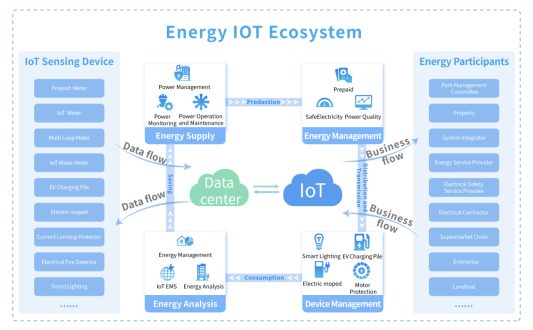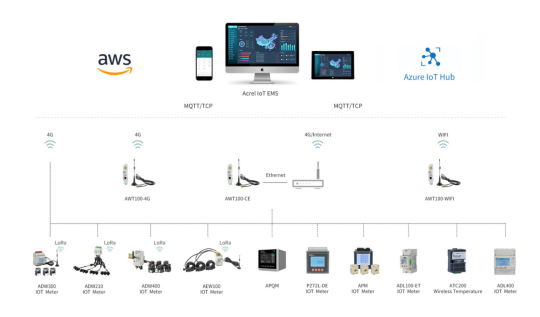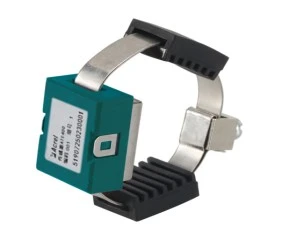

1. Business Backgrounds
The government has successively carried out and promoted the pilot work of smart cities, and the policy dividends related to smart cities have been continuously released. At the same time, a large amount of social capital has been attracted to accelerate investment. The demand for IoT-related smart city-level platforms and platforms for various industry solutions has grown rapidly.
The typical directions of smart city construction that our company has participated in include: safe electricity use, environmental protection electricity use, catering oil fume monitoring, battery car charging piles, building energy consumption, etc. In these directions, our company has participated in the construction of regional, city and even provincial data platforms.
2. Solutions
2.1 Energy IoT Ecosystem

2.2 Network structure
IoT EMS platform adopts a layered and distributed structure, which is mainly composed of three parts: perception, network layer and platform layer.
● Perception layer: Various sensors connected to the network, including multi-function meters, multi-loop meters, IoT meters, street light controllers, etc.
● Network layer: The intelligent gateway collects the data of the perception layer, performs protocol conversion and storage, and then uploads the data to the IoT EMS platform.
● Platform layer: including application server and data server, which can implement applications on PC or mobile.

2.3 Energy Supply
Ensure reliable power distribution, solve difficult operation and maintenance problems, and reduce labor costs.

Centralized power reading, monitoring power parameters in the power distribution system, and realizing remote signaling, telemetry, and remote control;
Operation and maintenance inspection management, the platform formulates inspection plans, the mobile terminal performs check-in, inspection, and elimination of shortages, and the person in charge audits the closed loop.
2.4 Energy Management - Electrical Safety
Electrical safety monitoring, monitoring electrical parameters such as leakage current, cable temperature, fault arc in the power circuit, if the leakage current is too large, the cable temperature is too high, and there is a fault arc in the line, an alarm will be generated;
Smoke detection, monitor smoke status;
When the line is short-circuited, the circuit will be cut off within 150 microseconds, no dangerous sparks will be generated, and the short-circuit arc will be extinguished;
Video surveillance, monitoring video in public areas;
Hidden danger management, APP, SMS, email, DingTalk, voice and other methods to remind and close the loop processing of hidden dangers;
Operation and maintenance inspection management, the platform formulates inspection plans, the mobile terminal performs check-in, inspection, and elimination of shortages, and the person in charge audits the closed loop
2.5 Device Management - Smart Lighting
1) Operation monitoring, real-time monitoring of the lighting status of the lighting area;
2) Remote centralized control, the platform side performs operations such as light switch, brightness adjustment, scene switching, running time setting, etc.;
3) System linkage, connect the fire protection system through dry contacts for linkage.
2.6 Energy analysis
Energy consumption monitoring, monitoring the energy consumption of electricity, water, gas, cold, heat and other categories of branches, and triggering an alarm when the energy consumption exceeds the standard;
Energy consumption analysis, trend analysis and year-on-year comparison analysis of energy consumption of each category;
Multi-rate statistics, statistical analysis of the peak, peak, flat and valley power consumption of the branch;
Energy flow diagram, showing the flow of energy by category within the enterprise;
Data report, data collection report, branch road cost report, capacity demand report, etc.;
Sub-item energy consumption, statistics of sub-item electric energy such as lighting sockets, air conditioners, power, and special electricity consumption in buildings;
Carbon emission management, trend analysis and year-on-year analysis of regional carbon emissions;
Energy cost analysis, statistics on classified energy costs, trend analysis and year-on-year analysis, including multiple rates, capacity fees, demand fees and other energy fees.
 English
English 日本語
日本語 한국어
한국어 français
français Deutsch
Deutsch Español
Español italiano
italiano русский
русский português
português tiếng việt
tiếng việt Türkçe
Türkçe العربية
العربية










